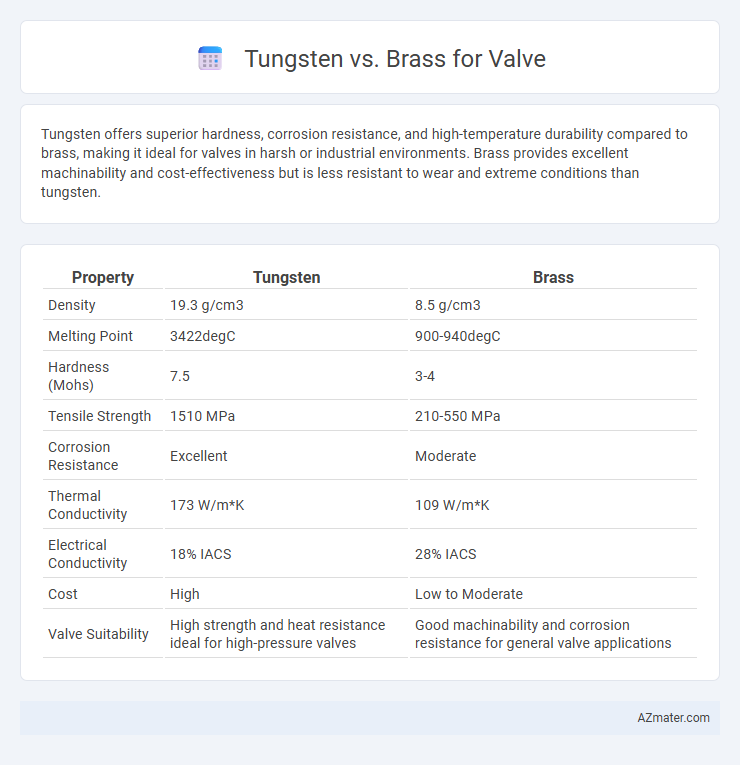Tungsten offers superior hardness, corrosion resistance, and high-temperature durability compared to brass, making it ideal for valves in harsh or industrial environments. Brass provides excellent machinability and cost-effectiveness but is less resistant to wear and extreme conditions than tungsten.
Table of Comparison
| Property | Tungsten | Brass |
|---|---|---|
| Density | 19.3 g/cm3 | 8.5 g/cm3 |
| Melting Point | 3422degC | 900-940degC |
| Hardness (Mohs) | 7.5 | 3-4 |
| Tensile Strength | 1510 MPa | 210-550 MPa |
| Corrosion Resistance | Excellent | Moderate |
| Thermal Conductivity | 173 W/m*K | 109 W/m*K |
| Electrical Conductivity | 18% IACS | 28% IACS |
| Cost | High | Low to Moderate |
| Valve Suitability | High strength and heat resistance ideal for high-pressure valves | Good machinability and corrosion resistance for general valve applications |
Introduction to Valve Materials: Tungsten vs Brass
Tungsten and brass are prominent materials used in valve manufacturing, each offering distinct mechanical properties and corrosion resistance. Tungsten, known for its exceptional hardness and high melting point of 3422degC, provides superior durability and wear resistance in demanding industrial applications. Brass, an alloy of copper and zinc, is favored for its excellent machinability, moderate strength, and natural resistance to dezincification, making it suitable for residential and low-pressure valve systems.
Material Composition and Properties
Tungsten valves exhibit exceptional hardness and high melting points due to their dense atomic structure and tungsten's atomic number 74, making them ideal for high-temperature applications. Brass valves, typically composed of copper and zinc alloys, offer excellent corrosion resistance and superior machinability, suitable for standard pressure systems. The choice between tungsten and brass for valves hinges on operational temperature requirements and durability needs, with tungsten favored for extreme environments and brass for cost-effective, moderate conditions.
Strength and Durability Comparison
Tungsten valves exhibit superior strength and durability compared to brass, with tungsten's hardness rating of 7.5 on the Mohs scale far exceeding brass's approximate rating of 3.5, making tungsten highly resistant to wear and deformation under high pressure. Tungsten alloys maintain structural integrity in extreme temperatures and corrosive environments, whereas brass, being softer and more prone to corrosion, may degrade faster in demanding applications. This enhanced durability and resilience make tungsten valves ideal for industrial uses requiring long service life and minimal maintenance.
Corrosion Resistance in Valves
Tungsten exhibits superior corrosion resistance in valves due to its high chemical stability and resistance to oxidation, making it ideal for harsh environments involving acids and salts. Brass, while commonly used for valve components, is more prone to dezincification and corrosion in aggressive or chloride-rich conditions. Choosing tungsten over brass enhances valve longevity and reliability in applications requiring exceptional corrosion resistance.
Temperature and Pressure Handling
Tungsten valves exhibit superior temperature and pressure handling capabilities compared to brass, with tungsten maintaining structural integrity at temperatures exceeding 3000degC and pressures above 100,000 psi. Brass valves, while corrosion-resistant and cost-effective, typically withstand temperatures up to 400degC and pressures around 3,000 psi, making them more suitable for low to moderate conditions. The high melting point and tensile strength of tungsten make it ideal for extreme environments requiring robust durability and thermal resistance in valves.
Cost and Availability Analysis
Tungsten valves exhibit superior durability and high-temperature resistance but come with significantly higher costs and limited availability due to scarce raw materials and complex manufacturing processes. Brass valves offer a cost-effective alternative with widespread availability, benefiting from abundant copper and zinc sources and simpler fabrication methods. The cost disparity often positions brass as the preferred choice for standard applications, while tungsten suits specialized environments where performance justifies the premium.
Machinability and Manufacturing Aspects
Tungsten exhibits exceptional hardness and high melting point, making it challenging to machine compared to brass, which is renowned for excellent machinability due to its softer nature and low cutting resistance. Brass allows for faster production rates and finer tolerances in valve manufacturing, reducing tool wear and operational costs. Tungsten valves offer superior durability and resistance to high temperatures but require advanced machining techniques such as EDM or grinding for precision shaping.
Application Suitability: Industrial and Residential Use
Tungsten valves offer exceptional wear resistance and high-temperature tolerance, making them ideal for industrial applications involving abrasive fluids and extreme pressure conditions. Brass valves provide excellent corrosion resistance and machinability, which suits them well for residential plumbing and low-pressure systems. The choice between tungsten and brass valves depends on specific operational demands, with tungsten favored in harsh environments and brass preferred for cost-effective residential water supply.
Maintenance and Longevity Factors
Tungsten valves exhibit exceptional wear resistance and corrosion durability, significantly reducing maintenance frequency and extending operational lifespan compared to brass valves. Brass valves, while cost-effective and easier to machine, are more susceptible to deformation and corrosion under high-pressure or abrasive conditions, leading to increased maintenance efforts. Selecting tungsten valves enhances longevity and reliability in demanding environments, minimizing downtime and maintenance costs.
Environmental Impact and Sustainability
Tungsten valves offer superior durability and longer service life, reducing frequent replacements and minimizing waste generation compared to brass valves, which are prone to corrosion and wear. The mining and processing of tungsten involve higher energy consumption and environmental disturbance, yet its recyclability contributes to resource conservation. Brass production releases considerable amounts of CO2 and heavy metals, raising concerns about environmental pollution and sustainability in valve manufacturing.

Infographic: Tungsten vs Brass for Valve
 azmater.com
azmater.com